
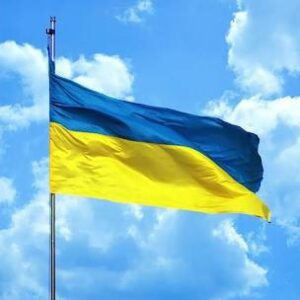
Please pray for the suffering people of Ukraine and the Palestinian people of Gaza and the West Bank.
Introduction
Why a rerun? Because I’ve spent the week dealing with a nasty case of the Covid, and I’m just not up to producing a fresh Post. (Though hardly anybody is paying attention, Covid is making the rounds again this summer, and is expected to get worse this fall.)
Had I been vaccinated? Yes, every time it was available. Does this mean I now disbelieve in vaccinations? Wrong! No way! Covid vaccinations are not yet as foolproof as measles vaccination, which had essentially wiped out measles, until the anti-vaxxers came along. God help us if they begin to disbelieve in polio vaccinations. I remember the terror of polio when I was a boy. Statistically, Covid vaccinations have greatly diminished the number of Covid cases. However, many today just ignore evidence – or facts about many things.
Alright. I will now get off my soapbox. *
- Crates used to ship soap once provided a raised platform for public speaking. (I’ll be you didn’t know that. Neither did I.)
“Four Days on the Holy Mountain” is a good fit here: It follows next in my travel series. Besides, September is the ideal time to travel in Greece. European tourists have gone home. (Almost everybody in northern Europe gets the month of August off, and most go on vacation.) The summer heat has diminished. The water is warm for swimming – not that swimming is allowed on Athos.
STOP! If I don’t stop writing, I’m going to turn this into a full Post. Therefore, updated and backdated just a little:
My Travel Journal for Mount Athos
Though it is now almost September 2025, we are about to go to Mount Athos in September 2002.
As you may know, I kept daily journals on my travels, mostly to Greece, so that when I got too old to travel any more, I could read them and experience it all again – as now I do.
From time to time I like to share my journeys with you. This way women can come to Mount Athos, too! (Don’t tell the abbot.)
Back when I was a fresh Blogger I wrote about this trip, giving my general impressions. (Posts 4, 5, 6) Now I want to follow my journal day by day so I (and you) can try to catch the immediate feel of what it was like for this pilgrim. As in all journals I recorded things as they happened or as they occurred to me, which means this writing will be a bit disjointed. I’ve done just a little editing to clarify things expressed obscurely.
Getting there
Even before I was Orthodox I had wanted to visit the Holy Mountain. However I knew no modern Greek and had no guide, so was scared to attempt it.

But now… A man from our Saint Nicholas, Cedarburg, (previously an Episcopalian priest) had felt the calling and had been accepted and even ordained at Karakallou Monastery (Καρακάλλοu Μόνη) and had invited me to come and visit him. Also by now I knew at least enough Greek to ask the single most important thing: Που είναι η τουαλέτα? So I wasn’t quite so nervous about it.
Athos is in the northeast of Greece, and Karakallou is on the east coast of the Athonite peninsula, about 3/4 of the way down.
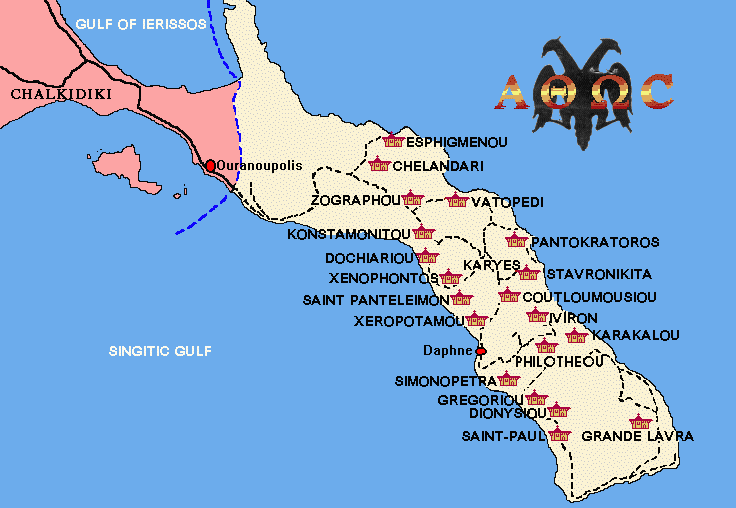
It dates to at least the Eleventh Century, founded either by the Roman emperor Karakallas or by a monk of the same name. It’s built like a fortress, and little wonder: It has been destroyed three times, once by the Latins (during their rule of Byzantium), then twice by pirates. The Ottomans, however, more graciously only stole Karakallou’s land. The monastery follows the strictest traditional Athonite discipline – as you definitely shall see!
It is no easy feat to get onto the Holy Mountain, and I’ve heard it’s tougher now since they are getting overwhelmed with pilgrims. Only men may enter. * In 2002, on any particular day, only ten non-Orthodox could visit, and only a hundred Greeks or other Orthodox. Non-Orthodox had to jump through a lot of hoops, and it wasn’t much easier for clergy who were not Greek Orthodox. We had to get permission from our superior (in my case, our Antiochian Metropolitan Philip, of blessed memory) and then from the Patriarch of Constantinople. If we got that far, then an entry permit had to be obtained from the Athos office when we got to Thessaloniki. Finally one’s passport had to be approved upon arrival in Karyes, the capitol of Athos, which is technically a self-governing and autonomous district of Greece.
- in the belief that women would give celibate monks too great a distraction from prayer
Nor is the place easily accessible by transportation. By air? Don’t be absurd. By boat? Possible but not allowed. You’ve got to take a bus from Thessaloniki east 139 kilometers (86 miles) to Ouranopolis (“heaven city”, though it’s a tourist town), then transfer to a boat down the west shore of the peninsula. After this, most people take a bus up to Karyes. Everywhere you look, monks, monks, monks. Then you walk or take a car or van to the appropriate monastery. But this is far easier than not so long ago, when after you arrived by boat, then to get anywhere you had to walk. Some monasteries still aren’t accessible by road.
Nor does a person have free reign to roam once he gets to Athos. Normally pilgrims are allowed to stay for only four days, and must move from monastery to monastery each day.
However Father Barnabas somehow got a blessing for me to stay at Karakallou for the entire four days. I stood beside him at his place in choir and, with the monks, was allowed to reverence the icon screen and the abbot before services. I worked with the monks in the monastery kitchen each day. I wish I could have seen more monasteries while I was on Athos. But this was an even greater blessing – for a few days to genuinely enter into the life of an Athonite monastery.
So with Khouria Dianna’s * “blessing” (don’t forget that!) off I went to Mount Athos.
- My dear wife. In the Antiochian Archdiocese we use the Arabic title for the priest’s wife.
Let’s pick it up two days before my four-day visit there.
Tuesday September 16, Thessaloniki
This has no relevance to Athos, but it’s funny. Kind of. Upon arriving at Thessaloniki Αεροδρόμιο, I waited and waited and nobody came to the Passport office, so I just walked into Greece. No problem! as the Greeks say. *
- “No problem” except when I tried to get out of the EU and back into the USA – I, a man traveling alone with no record of where I had been or when. I hadn’t thought of that. I’ve never been questioned and x-rayed so much in my life, even at the doctor’s. I thought I’d never get out of DeGaulle or into O’Hare. And even there, as I was boarding the plane for Milwaukee, it was “Will you please step aside, sir.” Only later did I figure out what I’d done wrong. Nobody told me
Wednesday September 17, Thessaloniki
Getting my permit at the Athos Office went smoothly – very helpful people who spoke English.
Day One: Wednesday September 18
9:20 a.m. I’m sitting on the boat in Ouranopolis harbor waiting for departure at 9:45. 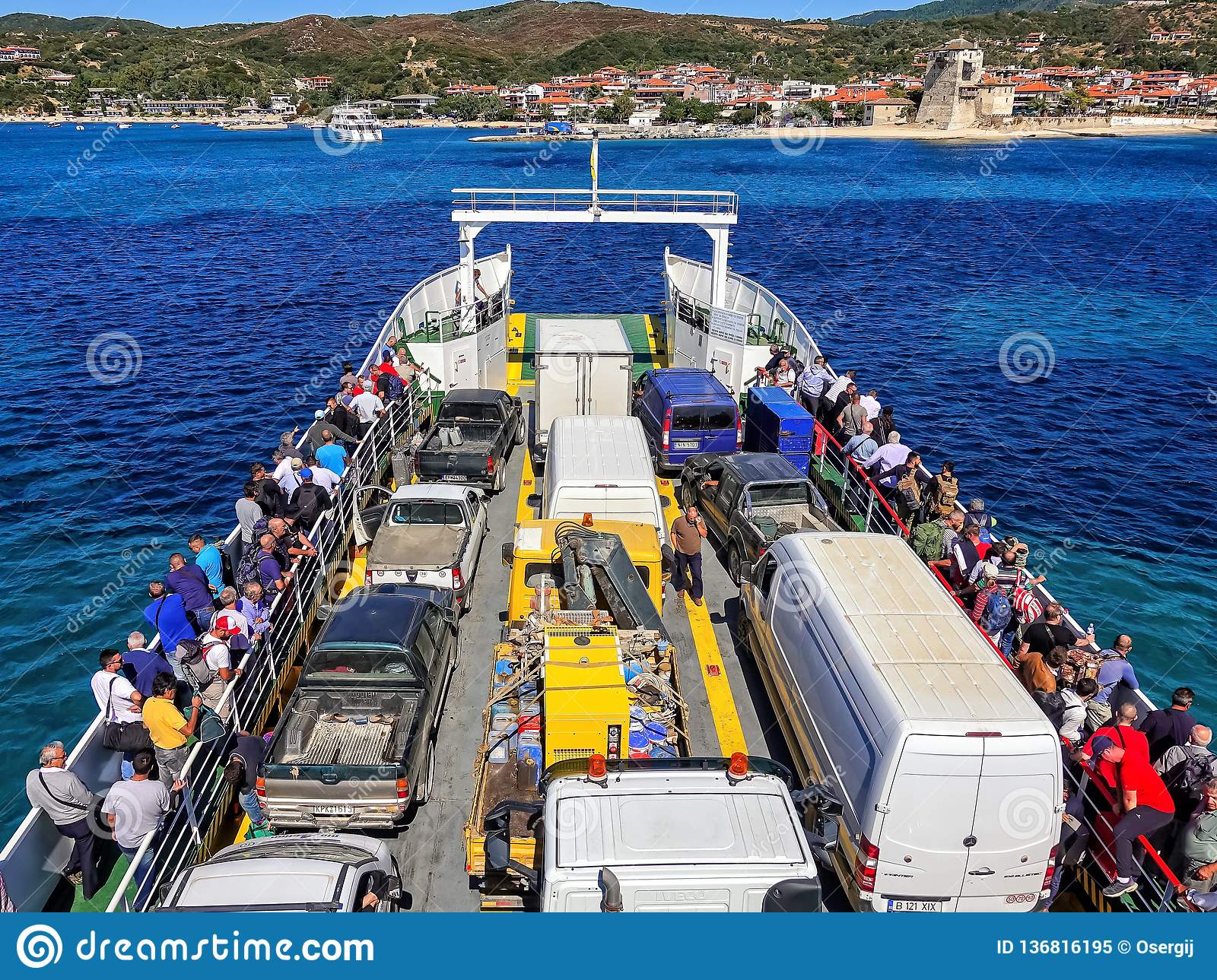 Probably. But just as the ticket lady at the train stasis said yesterday when I asked for a ticket on the 7:16 to Athens (which was posted plainly on the board): “It’s 7:00!” And as the agent at the bus station in Thessaloniki said this morning when I asked for a ticket on the express bus to Ouranopolis (the schedule of which also was clearly posted right behind her): “No express bus!” This is Greece!
Probably. But just as the ticket lady at the train stasis said yesterday when I asked for a ticket on the 7:16 to Athens (which was posted plainly on the board): “It’s 7:00!” And as the agent at the bus station in Thessaloniki said this morning when I asked for a ticket on the express bus to Ouranopolis (the schedule of which also was clearly posted right behind her): “No express bus!” This is Greece!
I was up at 4:30 this morning after virtually no sleep – haven’t adjusted yet after the flight over, and was excited and also afraid of missing the bus. I finally dropped into a deep sleep about 4:20 – for ten minutes! The trip east was beautiful through wooded (pine) mountains. Everything was green and it looked rather like the Appalachians. It’s also a crystal clear day, about 70, only a light breeze. Maybe Father Ted’s hat *  won’t blow off…?
won’t blow off…?
* a “skoufa” which I borrowed from a Greek priest friend, so I would be dressed appropriately. It was a bit small for me.
Look way down the coast – high mountains! Mount Athos?
9:47 a.m. The boat is leaving, almost on time.
10:45 a.m. A gorgeous trip down the coast. Soon after Ouranopolis the houses stop and Athos begins. This seems odd already – where are the women? We stopped at two or three monasteries and passed more high up, each more spectacular than the last. Otherwise it is empty land: cliffs, valleys, forest. The smell of pine and basil – and cigaret smoke! One old monk – large, white hair and beard, ascetic looking – suddenly pulled out 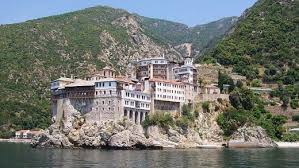 his cell phone and had an animated conversation. I’m guessing that Athos may not be quite as isolated from the world as I thought. I must be turning Greek, for I understood the last announcement: Next stasis – Ζωγράφου [Zografou].
his cell phone and had an animated conversation. I’m guessing that Athos may not be quite as isolated from the world as I thought. I must be turning Greek, for I understood the last announcement: Next stasis – Ζωγράφου [Zografou].

7 p.m. The bus ride up to Karyes this morning was hair raising – gravel road up the side of a cliff, with no guard rails, but hanging over the edge at every turn. A nice Greek guy befriended me, also going to Karakallou, and helped me find the way. Another crazy ride to Karakallou in a van driven by a mad monk. It’s a beautiful location with Mount Athos high above, and the blue Aegean below. We got the traditional welcome, with ouzo and loukoumi (Turkish delight, but don’t tell the Greeks). And there was Father Barnabas, whom I scarcely recognized 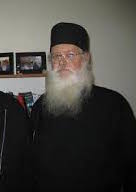 with his long beard. At Vespers I stood in the monks’ stall next to him.
with his long beard. At Vespers I stood in the monks’ stall next to him.
The monks here are youngish for the most part – about 32 of them, they say, with 6 novices and also a few others. Such a change from 20 or 25 years ago when Athonite monks were thought to be a dying breed. There are about 40 visitors, again many of them young. Greece seems to be having a spiritual revival, especially among the young men. *
- I later saw signs of this out in the “world” – men wearing prayer ropes, for example, and making the sign of the Cross as we passed churches.
The temple is very ornate, as expected. I know enough Greek to know we’re commemorating the ταξιάρχη/taxiarchi, archangels – on the “old calendar”, 13 days after home and the rest of Greece, because Athos is on the old calendar. And we’re also on Byzantine time: the Orthodox day begins at sunset, of course, which is 6 a.m. our time here, if I understand this which I think I don’t.
The supper consisted of beans, bread, tomatoes. [Should I include the following…? well, ok, it’s in my journal.] I prayed against gas (having thoughtlessly brought no Beano) and it worked! We venerated relics: the True Cross, St Charalambos’ skull, etc. Then I went for a walk with with Father Barnabas who is obviously happy here. He has found his home.
Now it’s quiet except for voices talking quietly in a small meeting room down the hall, with windows overlooking the Aegean. My room is up about 6 stories looking northeast across the sea towards the island of Thassos. Beautiful. Can hear a slight rush of sea from below. The Midnight Office and Orthros will begin at 2 a.m.! Liturgy about 4:30.
P.S. I lost my gibby [rassa, cassock] somewhere on the trip here. My backpack came open at the bus station. That must have been it, but how could something that big and black just disappear…? and who would steal such a thing on the way to Mount Athos? Father Barnabas loaned me one for my time here.
Day Two: Thursday September 19, 7 p.m. (somebody’s time) – about 75, sunny
Do I smell of fish? Yes. More on this later!
I slept from 9 pm. till 2 a.m. Not long after came a knock on my door. It was the Finnish guestmaster: “Pater, it is time for the service”. So I roused myself with great difficulty and finally joined Orthros at 3. It’s because I’m a priest that I stand with the monks up front in the stall next to πάτερ Βαρνάβας/Pater Barnabas. I didn’t expect that. I am πάτερ Βασίλειος/Pater Basilios here, since Basil is my Orthodox “Chrismation name”. Don’t ever tell the Athonites that I actually go by “Father Bill”!
Athonite services are so long that it is perfectly acceptable to walk out for a while and take a break. So we left briefly to look out over the sea at night. Oh! I can’t begin to describe it – the full moon and the stars!! Then our Liturgy was in an upstairs chapel. (Why do they celebrate several Liturgies in different locations? Odd.) They gave me the privilege of saying the Creed and the Our Father in English.
Breakfast: pasta, cheese, bread, wine, water. And it still wasn’t light outside!
3 hours of sound sleep, then Fr B brought coffee. The Finnish guest master brought Koulouria left and Loukoumia.
left and Loukoumia. 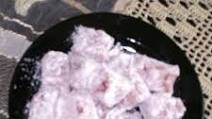 right
right
Then to the kitchen where I snapped green beans for a long time. (Don’t tell Dianna I have attained this skill!) Then we visited the temple and the altar, so I could have a good look around.
Can I describe the church for you now? No, I’ve forgotten, except that it was very dark. I wish I could have taken pictures, but they’re not allowed.
This is not Karakallou, but it was like this.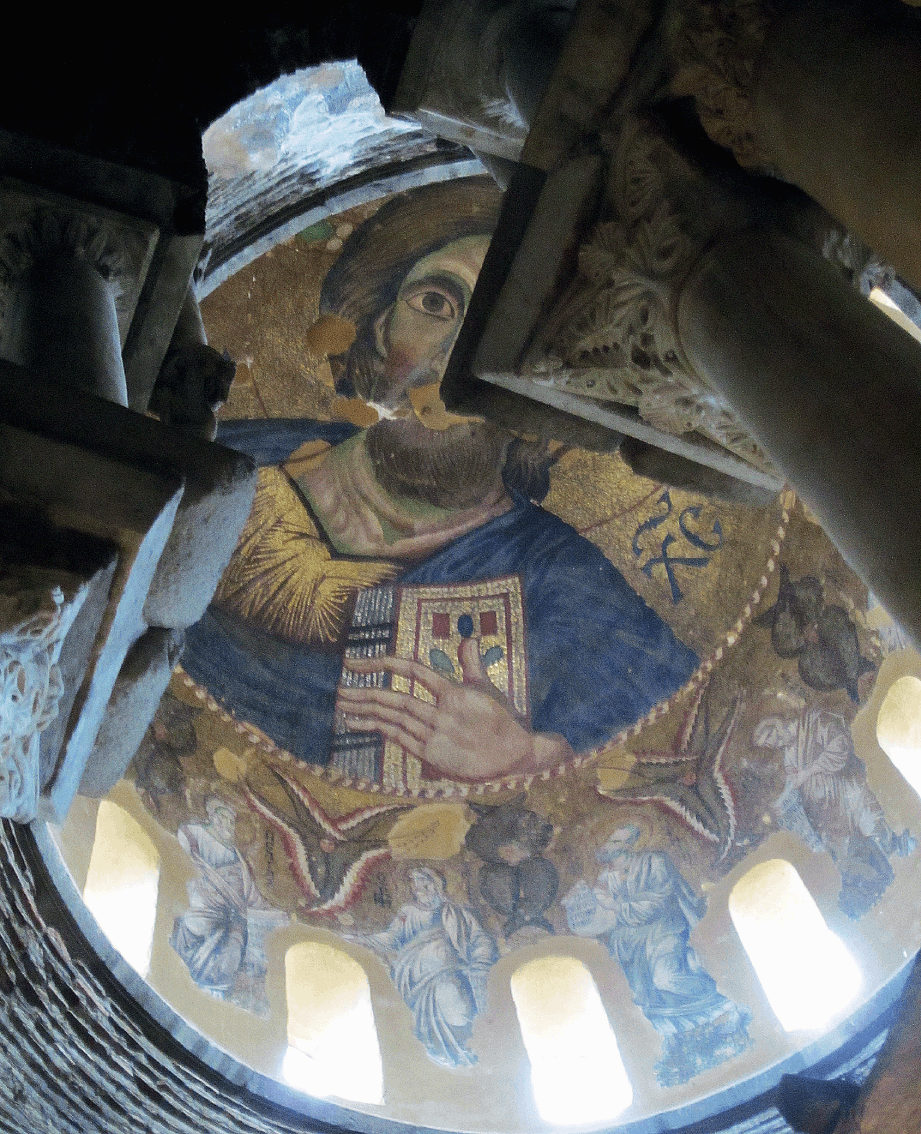
However, I discovered something: There was the Pantocrator far far up in the top of the dome, with light flowing in below Him.Yes! Above the dome of our sky is Christ the Pantocrator, above the light, Creator of all, presiding over all. The dome of the sky will never again look the same to me.
Father Barnabas told me the story of a man from Larissa who was dying of cancer, when he had a vision of a monk standing in front of a monastery with the sea below and behind, who said “You will be healed, but you must then come and visit me.” The man recovered very quickly, then began his quest. At last he came to Karakallou which looked to him like the place. He knocked at the door and asked “Do you have any saints here?” “Yes”, the guestmaster said, “Saint Gideon”. “May I see his icon?” 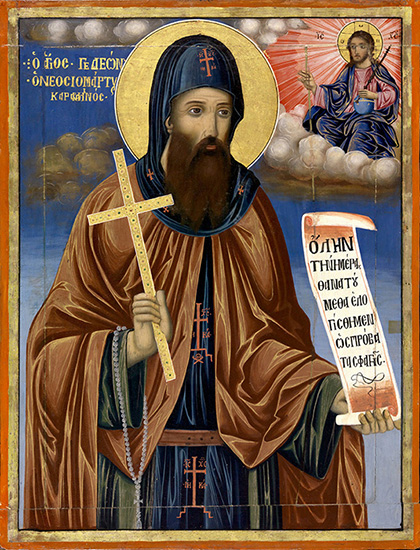 So they brought the icon left, and the man was disappointed. He said, “That’s not him.” The icon was an early 20th century rather “sentimentalized” one. The guestmaster said, “We do have a faded old icon of him” right which he found and brought out. “That is the one!” cried the man. “That is the monk who healed me!”
So they brought the icon left, and the man was disappointed. He said, “That’s not him.” The icon was an early 20th century rather “sentimentalized” one. The guestmaster said, “We do have a faded old icon of him” right which he found and brought out. “That is the one!” cried the man. “That is the monk who healed me!”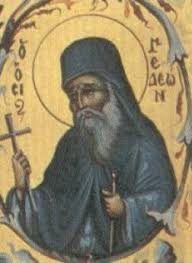 After that he visited Karakallou regularly.
After that he visited Karakallou regularly.
Then we cleaned little fish by hand for nearly two hours. Met Fr X, another monk from the US. Heard the story of how the abbot (actually called the “elder”, έροντας) claims that Coca Cola has urine in it, so when people donate Coke to the monastery, he gives it to a nearby school! ?!?! Surely that story can’t be correct.
As expected, services here are far more elaborated than I’m used to, but still very familiar. With Orthodoxy, even on Athos in Greek, I can easily know where we are.
The abbot came by and said he thought it was a waste of time gutting the fish!
Byzantine time: sunset = midnight in our secular terms, the beginning of the new day and they actually live by that here. Very confusing.
Then Vespers, supper (beans, cheese, bread, wine again). At Compline, the abbot kissed my hand. I’m accepted! He seems stern, holy, charismatic. It’s now 6:50 and I’m exhausted. We’ll be up at 3 for Matins. Tomorrow night comes a nine hour All Night Vigil.
Next Week we’ll complete our pilgrimage to Athos.
Week after next: from the sublime to the… I don’t know what to call it, but it’s a whole lot worse than “ridiculous”: The Curren’t Administration’s War on Science.
«Statistically, Covid vaccinations have greatly diminished the number of Covid cases. »
— Show me any peer-reviewed study that purports that Covid vaccinations have greatly diminished the number of Covid cases, give me two to three to four minutes for each page, and I will show you that the study does not show such a thing.
Dear Manfred: I’m sorry I’ve been slow in responding. I’ve been testing Covid-19 for myself! and am just beginning to recover.
My big mistake was comparing Covid to measles and polio. These latter two are relatively stable diseases, so that vaccinations almost always are effective. Covid is forever mutating, so it’s hard to measure the effect of vaccinations.
In questions like this sort I usually turn to our daughter Jennifer who was only a thesis short of having a Masters in Epidemiology. (She got married and had a family instead, but she follows these matters carefully.) The following was her response:
It’s actually true that the boosters have become less effective in decreasing the number of cases than they were in the beginning of the pandemic.
The reasons for why the boosters don’t lead to a reduction in cases is based on a lot of different things – an obvious one is how different our behavior was on a national level at the beginning of the pandemic – staying home, wearing masks, etc. – plus then you add in the individual choices people made along the way, with some people choosing not to get vaccinated or mask, etc., and all the different combinations of behavior people adopted along the way at different times – PLUS then of course the different state-level mandates for schools, businesses.
It gets really, really difficult to piece out exactly how much boosters decrease cases now, when everyone has some level of immunity due to boosters and/or getting the virus, and every person’s immune level is based on things like their own immune system, how long it’s been since they were infected or boosted vs. how well the vaccine worked at the very start, on a population that was generally naive to the virus except for people who had already caught covid pre-vaccines.
Obviously it would have had a more noticeable effect on case reduction at the earlier points. However – the value of the boosters now is their ability to reduce severe illness, hospitalizations, long covid, and the like.
It’s much safer to be exposed to covid through the boosters vs. getting infected.
https://www.cdc.gov/covid/vaccines/benefits.html
https://www.mdpi.com/2673-8112/3/10/103
These are a couple earlier articles that discuss the topic.
In the first paper, if you scroll down to sections 4 and 5 (discussion and conclusion), it lays things out in relatively understandable language. Also reminded me of an obvious point I forgot to mention – the virus is always mutating, which also factors into how difficult it is to accurately measure things like absolute rates of case reduction – you’re just never going to be comparing apples to apples in these studies, for so many reasons.
But the data out there shows that there is/was some reduction in transmission with vaccination – but it’s most valuable for reducing immediate severity and also long-term health issues associated with Covid.
https://www.thelancet.com/journals/lanwpc/article/PIIS2666-6065(23)00248-1/fulltext
After a while, one just ends up playing “study vs. study” – it’s always possible to find an article that backs up your personal point of view (and there are scientific-looking journals out there that accept trash studies for publication). Determining exactly how well-designed a particular study is takes a good amount of time, and is usually beyond my pay grade! But in reading information from people I trust, I think it’s safe to say that there IS evidence for case reduction.
But it isn’t the main benefit to the vaccinations, or at least not to the boosters.
I sent a reply already hours ago.
It is not visible.
Why is that?
Take it easy, man. It’s because I didn’t receive it. The last message I received from you was at 1:50 on 09/04/2025, below.
That’s the one that I did not see displayed when I wrote the reply above.
Anyway, now it’s there. Thank you!
You write:
« Determining exactly how well-designed a particular study is takes a good amount of time, and is usually beyond my pay grade! »
— Granted. Determining that a study is well-designed will take a good amount of time, and a good deal of expertise.
But: Determining that a study is NOT well-designed can be done instantaneously as soon as one spots an instance of evident sloppiness, evident logical fallacy, maybe even: evident disingenuousness, evident statistical tricks, evident manipulative language or style of presentation.
And one does not need, for this particular area around the Covid-phenomenon, any expertise in university-level biology, chemistry or medicine to spot such instances. One does not even need to take recourse to university level statistics.
Anyone can do that.
That is, maybe, why so many, supposedly “simple” people like nurses or truck drivers did not fall for the propaganda: If they worked with the same accuracy and professional standards that one finds in studies published in, supposedly, reputable medical journals, there would be lots of, lots of more traffic accidents and iatrogenic deaths.
It takes years to learn to play the piano or drums.
But anyone can hear when a pianist hits the wrong key or a drummer doesn’t keep time.
Someone without a degree in literature might not understand every allusion to other works of literature when reading a novel.
But he can spot faulty orthography.
The point being:
Anyone can spot faults in a scientific study.
Even bishops and priests can do so before issuing any advice or making any comments, if they look at the studies.
Did they look?
The Lancet study:
https://www.thelancet.com/journals/lanwpc/article/PIIS2666-6065(23)00248-1/fulltext
« We conducted a population-based data linkage study among people living in the Greater Sydney Metropolitan Area, New South Wales, Australia between June and November 2021. »
Now, if you look at Worldometer, there was not much going on in Australia Covid-wise UNTIL November 2021:
https://www.worldometers.info/coronavirus/country/australia/
The Lancet study further states:
« Further, our study setting was characterized by the absence of widespread community transmission prior to our study period, heavily restricted mixing and movement outside households during the study period, high levels of centralised testing of suspected cases, and rigorous contact tracing and testing. »
Crucial: Were «vaccinated » and « unvaccinated » subject to/encouraged to the same strictness and frequency of testing?
It further states:
« At the same time, a very high level of testing coverage using polymerase chain reaction (PCR) assays at central testing facilities was maintained, as well as extensive contact tracing.13–15. »
— Exactly what assays? Where are they defined in this study? Were those assays standardized, with no variation between various facilities and throughout the period of this study?
« We designated the earliest recorded case of COVID-19 among members of each household as the index case for the household. »
— Were all other household members tested for antibodies in order to establish who had had prior exposure, and who had not?
« Household contacts recorded as having tested positive within 14 days of the index onset date, as defined by the contact onset date, were classified as ‘positive contacts’, while household contacts without onset dates during that period were classified as ‘negative contacts’. »
« We classified the vaccination status of household contacts by the number of doses received and the most recent date of vaccination prior to the index onset date as follows: (a) ‘unvaccinated’ if they had received no vaccine or their first dose was less than 21 days prior to the index onset date; (b) ‘partially vaccinated’ if they received one dose or their second dose less than 14 days before the index onset date; (c) ‘fully vaccinated’ if they received their second dose 14 or more days before the index onset date; and (c) ‘waning’ if they received their second dose three or more months before the index onset date. Third doses (boosters) had not been made available widely at this stage in Australia.25 The vaccination status of index cases used the same classification system. Vaccines were grouped by type into: (a) ‘vector’ (AstraZeneca); or (b) ‘mRNA’ (Pfizer or Moderna). »
>>> The vaccine efficacy illusion revisited
https://m.youtube.com/watch?v=Gkh6N-ZL3_k
The Lancet study further states:
« We used percentages, medians and inter-quartile ranges (IQR) to describe the distribution of characteristics among index cases and household contacts. We calculated crude odds ratios (cOR) with 95% confidence intervals (95% CI) of the risk of infection for household contacts in relation to specific categorical variables using a logistic regression model with a random intercept for household. We then built a multivariable logistic regression model, again with a random household factor, adjusting for all pre-identified potential confounders, to calculate the adjusted odds ratios (aOR) and 95% CIs of the effects of vaccination status and type of vaccine received on the risk of infection for household contacts. »
— So what? What matters in statistics is, generally, not those fancy calculations, but
— what you count
— when you count
— how you count
All those fancy calculations might impress the reader, or, more important: the sponsor of the study, but: they don’t matter if the counting itself is unsound.
« As shown in Supplementary Material 3, there was a consistent and substantial reduction in the cORs for household contacts with improving vaccination status (unvaccinated, partially vaccinated, fully vaccinated) of both the household contact and the index case. »
— That would be shown if all, regardless of their vaccination status, were subject to exactly the same testing requirements: Tested at the same intervals, at the same times. Is that the case? I see no evidence for that. Do you?
« To our knowledge, this is the first study presenting robust, adjusted estimates for the effects of the vaccination status and types of vaccines on the transmission risks within households. »
— What exactly is robust about this study?
« We acknowledge several limitations. »
You better do.
Manfred, I don’t want to leave your submission unanswered, However I don’t understand much of what you sent me. Except for theology, I’m a simple man. Regarding medical matters, I trust my primary doctor whom I have been with for over thirty years and who has guided me right every time, so that at age 87 he rates my health as very good. When he says “get the vaccine”, I do so. All other medical professionals I know have said the same. I have received every Covid shot that was available and (though I work in a profession which requires almost constant close contact with people) I never came down with Covid till now, and this was a mild case. Other clergy I know have had the same experience. Maybe it’s only the Hand of God that protects us! That’s all I know.
Father Bill,
You write:
« Manfred, I don’t want to leave your submission unanswered, However I don’t understand much of what you sent me. »
— What I myself wrote is very simple; the pseudo-scientific-jargon is in the quotes, clearly marked by quotation marks, from the Lancet-article that you yourself linked to in your reply to my original comment.
Furthermore, my comments following the quotes clearly show that I myself don’t have any expertise on those matters, nor pretend to have such expertise.
I am just making observations and asking questions.
I am as much a simple man as you, Father Bill (in fact even more so; I even don’t know a thing about theology) — but that is exactly the point:
Lord Sumption, March 2020:
« Q: There will be people listening who admire your legal wisdom but will also say, well, he’s not an epidemiologist, he doesn’t know how disease spreads, he doesn’t understand the risks to the health service if this thing gets out of control. What do you say to them?
A: What I say to them is I am not a scientist but it is the right and duty of every citizen to look and see what the scientists have said and to analyse it for themselves and to draw common sense conclusions. We are all perfectly capable of doing that and there’s no particular reason why the scientific nature of the problem should mean we have to resign our liberty into the hands of scientists. We all have critical faculties and it’s rather important, in a moment of national panic, that we should maintain them. »
https://unherd.com/newsroom/lord-sumption-on-the-national-coronavirus-hysteria/?set_edition=en
Also:
A simple man:
https://m.youtube.com/watch?v=EqDd06GW76o
If only Columbo had always listened to the experts!
https://m.youtube.com/@Columbo/featured
You further write:
« I have received every Covid shot that was available and (though I work in a profession which requires almost constant close contact with people) I never came down with Covid till now, and this was a mild case. »
— Fine. As you volunteer to mention that you got every Covid shot, allow me to ask you:
Did you yourself, Father Bill in Wisconsin, receive proof of vaccination via QR-code or entry in your vaccine-passport,
a) immediately after vaccination or
b) after a 21-day- or 14-day delay?
Furthermore, are you aware of any US city, county, state, or any other country, where those who got vaccinated got their QR-code or entry into their vaccine passports allowing them to access venues which non-vaccinated were not allowed to access, or only allowed to access after additional testing which the vaccinated were not required to undergo, only after a 21-day- or 14-day delay (which determines the threshold for being categorized as unvaccinated/vaccinated in the Lancet-study that you linked to), instead of receiving that QR-code or entry in their vaccine-passports immediately after vaccination?
You wrote:
« Except for theology, I’m a simple man. »
Still, in your article titled « Four Days on the Holy Mountain: Part One (a rerun) » you chose to state that:
« Statistically, Covid vaccinations have greatly diminished the number of Covid cases. However, many today just ignore evidence – or facts about many things. »
I am looking forward to this comment being displayed, too, Father Bill.
Dear Manfred:
I appreciate your research and writing on this subject. However, for myself I am ending our dialogue now.
I know that experts/scientists can be wrong and on rare occasion have been. However, when there is a strong consensus on their part, odds are very high that they are right. Also, I was trained in and trust the scientific method. Therefore, especially in what I write for public consumption, I go with the consensus.
That is why, regarding Covid, I have taken the advice of my doctors and nurses and all other medical authorities I know personally – and also the advice of the WHO, NIH and CDC (before its recent destruction).
However, I will be glad to publish anything else you submit for the enlightenment of others. Perhaps others will want to take up the debate.
Father Bill
Father Bill,
Thank you very much for your reply.
Just a few comments on that, and then I will end this, too.
First, I observe that you did not address a single observation/question of mine that I brought up in relation to the Lancet-article that you had linked to.
Second:
You write:
« I know that experts/scientists can be wrong and on rare occasion have been. »
— On rare occasion? Modern science, and its precursors, have been moving forward with lots of, lots of errors, detours and misunderstandings along the way.
Also, famously: The professional group with the highest percentage of membership in the Nazi-party or one of its affiliated organizations were: medical doctors (roughly half of them).
It was a considerable part of medical doctors who were convinced of, or otherwise: for opportunistic reasons or out of laziness, supported the Nazis’ “biology”-based racism.
It was simple proletarians, peasants, prostitutes in Germany and occupied territories who saved some Jewish lives by hiding the persecuted. (And: some doctors saved lives, too.)
Third:
You write:
« However, when there is a strong consensus on their part, odds are very high that they are right. »
— I am not really sure how to calculate those odds.
Nor am I sure whether those odds matter at all when discussing a single, specific issue.
What I am sure of: Referring to – supposedly – high odds of the majority, or rather: that which is presented as the majority position among scientists being right, while not responding to a single observation raised and question asked amounts to:
Evading the questions.
Regarding consensus in the medical profession:
https://www.britannica.com/biography/Ignaz-Semmelweis
https://hitchensblog.mailonsunday.co.uk/2020/08/this-should-have-been-my-monthly-column-for-the-anmerican-magazine-first-things-.html
Fourth:
You write:
« Also, I was trained in and trust the scientific method. »
So was I and so do I, though the training was, in my case, very limited only, at the intersection of social sciences and humanities, which, in German language, are “science” (= “Wissenschaft”), too: “Geisteswissenschaften”.
And exactly because I was, a little bit, trained in and do trust in the scientific method, I would, before going with the “consensus”, try to see:
Is that which is presented by the dominant mass media and politicians really a consensus?
Or is the perceived consensus in fact skewed, by, on the one hand, silencing, censoring, smearing highly qualified doctors and scientists who voice dissident views, and, on the other hand, by funding countless studies which probably nobody, including most doctors, ever reads, but which then skew the outcome of those oh-so-significant meta-studies?
And there were quite a few doctors and scientists who did speak out and who were smeared, ridiculed, defamed.
There was, in antiquity, a controversial thinker who did not say:
« I go with the scientific consensus. »
What he did say was:
https://www.biblegateway.com/passage/?search=Matthew%205%3A6%2C10&version=RSV
Dear Manfred:
I did not answer you in detail, because I knew that would cause you to do the same, and this would never stop.
This is not intended to continue our debate. I just wanted to say that I agree with most of what you said in your last letter. And I’m not going to say any more lest we get into a debate about that!
God bless you and your wife. Please feel to write anytime you wish.
in Christ,
Father Bill
Dear Fr. Bill,
God bless you for your patience and understanding with Manfred Meyer.
I don’t often read your very interesting blogs, but always find them delightful and helpful – helpful because I still feel like a baby Orthodox only since 2008 after nearly 50 years of the Roman Church when at about 22 I began looking for the original church of the 1st century – Protestants talk and sing about God but don’t sing to, praise and supplicate/talk to ie worship God. At 88, how many more years till passing through to the other side? “May you have many, many years.”
Just the past 2 years have I finally understood in my very being what it means to live just in the world and not of the world where I belong in God’s world – hard, hard if doing by myself, easy and comforting when I really know and experience it that God is the one in charge of my life and pray to God to keep reminding me of that. I find it is a constant struggle to understand just which side of the line am I on, and am I really repentant. Fr. John Oliver, my priest at St. Elizabeth (the New Martyr) Orthodox Church in Murfreesboro TN tells me I have many years yet. My aging body parts say maybe not.
May God continue to bless you with your ongoing blogs – wow, so many years and still providing weekly blogs, though I guess it is sorta like needing to do a homily every week if you feel the need to provide the type of blog you do. Anyway, many people I believe love them.
In Christ, Juliana
Dear Juliana:
How nice to hear from someone older than me – though not by much!
And thank you for the kind words. I keep writing because: 1) I’ve just got to! It’s built into me. 2) It helps keep my mind moving at my advanced age.
I certainly don’t yet know what it means to be “in the world but not of it”. If it means to not take our moral standards from the world, you and I are both working on it. But if it means what some of the saints say – “not being attached to the world” – I’m not there. I hear Heaven (should I be admitted) is better than this. Yet there is so much in this world that I love and can scarcely bear to part with: today’s bright blue skies, music (mostly classical pop, not even religious), my church, my wife (I dread the day of parting) and children and grandchildren and friends. Am I still “of this world”? All I know is I’m not ready to let go of it, not yet. As if in the end we’ll have a choice!
Many years to you, too, Juliana. God bless and keep you.
in Χρ,
Father Bill